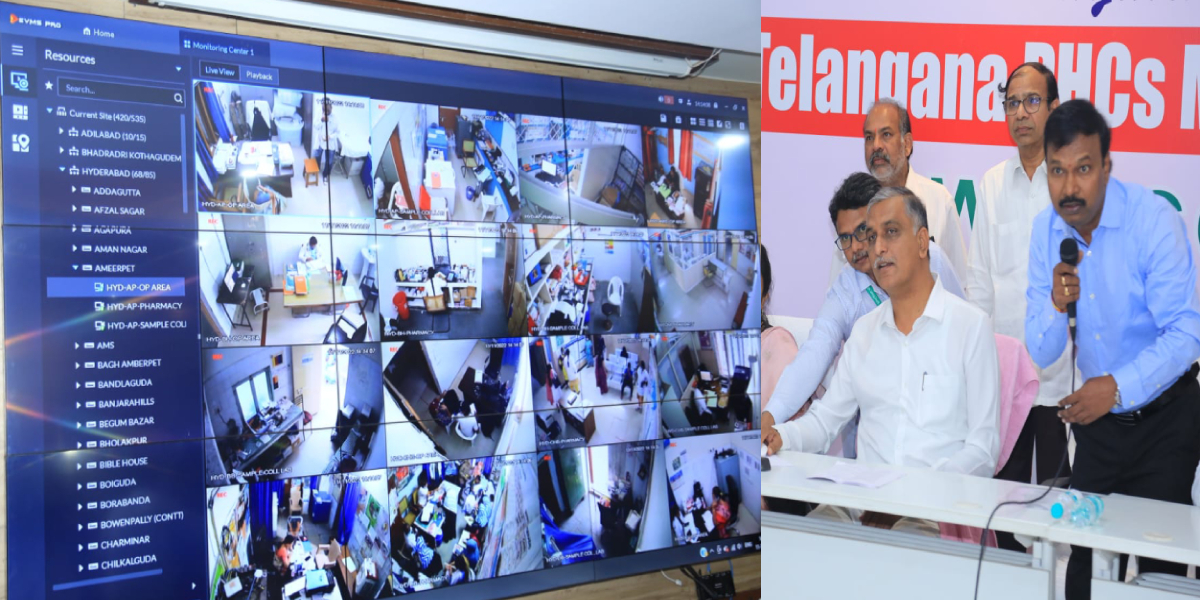Telangana Health Minister T Harish Rao inaugurated the Primary Health Centre Monitoring Hub at the Office of the Director of Public Health.

Telangana Health Minister T Harish Rao on Friday, 11 November inaugurated the Primary Health Centre monitoring hub in the Office of the Director of Public Health in Hyderabad. (Supplied)
Telangana’s 636 Primary Health Centres (PHCs) and 251 urban PHCs are now connected to a 24×7 centralised surveillance and command centre through a wide CCTV network.
The state’s Health Minister, T Harish Rao, inaugurated India’s first Primary Health Centre Monitoring Hub at the Office of the Director of Public Health in Hyderabad on Friday, 11 November.
The network, established at a cost of ₹7.5 crore, will monitor the PHCs and urban PHCs round the clock. Out-patient units, laboratories and pharmacies of all PHCs will be included in the network.
“We launched this system for the first time in the country”, Harish Rao told reporters. “It will play a vital role in strengthening the state’s primary health care”.
Explaining the benefits of the hub, the minister said the monitoring system would improve the quality of service the PHCs provide.
“Since they are constantly monitored, the staff will have to attend work, and their performance will improve. Besides monitoring the OPs, the hub will also have information on the availability of staff in the PHCs spread across the state”, Harish Rao pointed out.
The system would be helpful in case of a disease outbreak anywhere in the state. “The PHCs are located in remote areas. As many as 27,000 people work in these PHCs and all of them can be linked to each other at a single point”, he said.
“For example, if a disease outbreak is detected in an area, state-level experts can help in strengthening the medical services immediately by providing advice and suggestions through conferences”, he explained.
The minister added that the network could be used to provide specialty services in association with medical colleges and district hospitals.
“The PHCs have a constant flow of people. So security is paramount. We have witnessed several incidents of theft and crime at the PHCs. It is possible to prevent petty theft and crime”, he further said.
He added that the hub would aid in real-time monitoring. “If anything suspicious is found, the hub will detect it and immediately alert the respective PHC”, Harish Rao pointed out.
The minister also said that the monitoring hub could collect visual evidence of unwarranted situations. “It is better to know the controversies related to medical staff and accusations against them. We can find it easily through the monitoring hub”, he said.
He added that by preventing diseases at the primary stage, patients could be saved from developing complications, and thus reducing the pressure on the secondary and tertiary care units.
The health minister also announced that new buildings have been sanctioned for 43 PHCs at a cost of ₹67 crore. Repair and maintenance works of 372 PHCs have been taken up at a cost of ₹43.18 crore.
“We have sanctioned new buildings for 1,239 sub-centres. We are spending Rs 20 lakh each. We have already spent ₹247 crore. We have repaired 1,497 sub-centres at a total expense of Rs 59 crores — ₹4 lakh for each centre”, said Harish Rao.
The health minister said the introduction of Basti Dawakhan eased the rush at the OP units of secondary and tertiary units.
As many as 331 Basti Dawakhanas — health sub-centres — are functioning in the state. The Telangana government has decided to increase the number of Basti Dawakhanas to 500.
“So far, 2.11 crore OP visits have been recorded at these Basti Dawakhanas. Due to this, the pressure on hospitals, such as the Osmania Hospital, Gandhi Hospital and Fever Hospital has come down”, Harish Rao said.
Elaborating, he said Osmania Hospital had attended 12 lakh OP cases in 2019, which came down to 5 lakh this year. In Gandhi Hospital, the number of outpatients came down to 3.70 lakh this year from 6.5 lakh in 2019, and the Fever Hospital attended to 2 lakh OP cases, down from the 4 lakh patients it had treated in 2019.
“As a result, there has been an increase in surgeries at these tertiary healthcare centres,” Harish Rao said.

Apr 19, 2024

Apr 19, 2024

Apr 19, 2024

Apr 18, 2024

Apr 18, 2024